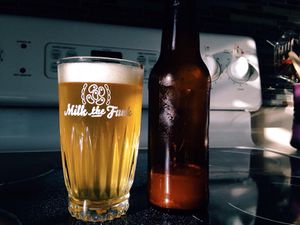Difference between revisions of "Berliner Weissbier"
| Line 1: | Line 1: | ||
| + | [[File:Berliner.jpg|thumbnail|right|Berliner Weissbier]] | ||
'''Berliner Weisse''' is a top-fermented, bottle conditioned wheat beer made with both traditional warm-fermenting yeasts and lactobacillus culture. They have a rapidly vanishing head and a clear, pale golden straw-coloured appearance. The taste is refreshing, tart, sour and acidic, with a lemony-citric fruit sharpness and almost no hop bitterness. | '''Berliner Weisse''' is a top-fermented, bottle conditioned wheat beer made with both traditional warm-fermenting yeasts and lactobacillus culture. They have a rapidly vanishing head and a clear, pale golden straw-coloured appearance. The taste is refreshing, tart, sour and acidic, with a lemony-citric fruit sharpness and almost no hop bitterness. | ||
Revision as of 09:22, 1 April 2015
Berliner Weisse is a top-fermented, bottle conditioned wheat beer made with both traditional warm-fermenting yeasts and lactobacillus culture. They have a rapidly vanishing head and a clear, pale golden straw-coloured appearance. The taste is refreshing, tart, sour and acidic, with a lemony-citric fruit sharpness and almost no hop bitterness.
Served in wide bulbous stemmed glasses, tourists in Berlin will often order on as a "Berliner Weisse mit Schuss: Himbeere" or "Berliner Weisse mit Schuss: Waldmeister". These are syrups that are added to make the sourness more palatable. Himbeere is raspberry (red) and Waldmeister is woodruff (green).
Typical average alcohol by volume (abv) range: 2.0-5.0%
General Best Practices
- Don't sour mash. Its too risky for off flavors
- Limit CO2 and do not aerate before pitching
- Pitch Lactobacillus between 90F and 120F depending on your Lactobacillus strain or blend for ~ 5-7 days (for more details see the Sour Worting page).
- Create a 1 liter Lacto starter for each 5 gallons at least 2 days in advance of brew day.
- Pitch Brettanomyces after cooling down after Lactobacillus fermentation phase
